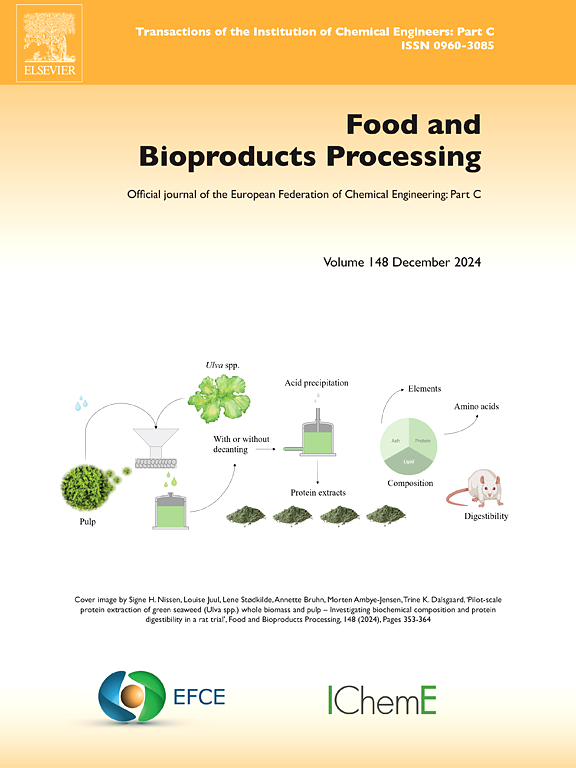Recombinant GH5_8 mannanase from Hungateiclostridium cellulolyticum: Biochemical and structural characteristics and applications for mannooligosaccharides production from spent coffee grounds
IF 3.5
2区 农林科学
Q2 BIOTECHNOLOGY & APPLIED MICROBIOLOGY
引用次数: 0
Abstract
Abundant agro-industrial residues, spent coffee grounds (SCG), are rich in polysaccharides, notably mannan, rendering them a promising substrate for the production of mannooligosaccharides (MOS) with potential nutraceutical applications. This work reports cloning, heterologous expression in E. coli Arctic Express and biochemical characterization of Hungateiclostridium cellulolyticum mannanase from GH5 family (HcGH5_8) and its application for producing MOS from pretreated SCG. The enzyme displayed optimal activity at pH 7.0 and 50 °C, with a specific activity of 687 ± 53 U/mg against konjac glucomannan under optimal conditions. Furthermore, hydrolysis of the SCG resulted in the release of mannobiose (M2), mannotriose (M3), and mannotetraose (M4) as the primary hydrolytic products. The impacts of different hydrothermal pretreatment conditions on the yields of the enzymatically-produced MOS were investigated.
从纤维素溶黄芽胞杆菌中提取的重组GH5_8甘露聚糖酶:生化和结构特征及其在用废咖啡渣生产甘露寡糖中的应用
大量的农业工业残留物,废咖啡渣(SCG)富含多糖,特别是甘露聚糖,使它们成为生产甘露寡糖(MOS)的有前途的底物,具有潜在的营养保健应用。本文报道了GH5家族黄芽胞杆菌甘露聚糖酶(HcGH5_8)的克隆、在大肠杆菌Arctic Express中的异源表达、生化特性及其在预处理SCG生产MOS中的应用。在pH 7.0和50℃条件下,该酶对魔芋葡甘露聚糖的比活性为687 ± 53 U/mg。此外,SCG的水解导致甘露糖(M2)、甘露糖(M3)和甘露糖(M4)作为主要水解产物释放。考察了不同水热预处理条件对酶制MOS产率的影响。
本文章由计算机程序翻译,如有差异,请以英文原文为准。
求助全文
约1分钟内获得全文
求助全文
来源期刊

Food and Bioproducts Processing
工程技术-工程:化工
CiteScore
9.70
自引率
4.30%
发文量
115
审稿时长
24 days
期刊介绍:
Official Journal of the European Federation of Chemical Engineering:
Part C
FBP aims to be the principal international journal for publication of high quality, original papers in the branches of engineering and science dedicated to the safe processing of biological products. It is the only journal to exploit the synergy between biotechnology, bioprocessing and food engineering.
Papers showing how research results can be used in engineering design, and accounts of experimental or theoretical research work bringing new perspectives to established principles, highlighting unsolved problems or indicating directions for future research, are particularly welcome. Contributions that deal with new developments in equipment or processes and that can be given quantitative expression are encouraged. The journal is especially interested in papers that extend the boundaries of food and bioproducts processing.
The journal has a strong emphasis on the interface between engineering and food or bioproducts. Papers that are not likely to be published are those:
• Primarily concerned with food formulation
• That use experimental design techniques to obtain response surfaces but gain little insight from them
• That are empirical and ignore established mechanistic models, e.g., empirical drying curves
• That are primarily concerned about sensory evaluation and colour
• Concern the extraction, encapsulation and/or antioxidant activity of a specific biological material without providing insight that could be applied to a similar but different material,
• Containing only chemical analyses of biological materials.
 求助内容:
求助内容: 应助结果提醒方式:
应助结果提醒方式:


